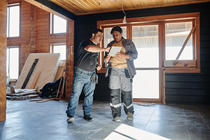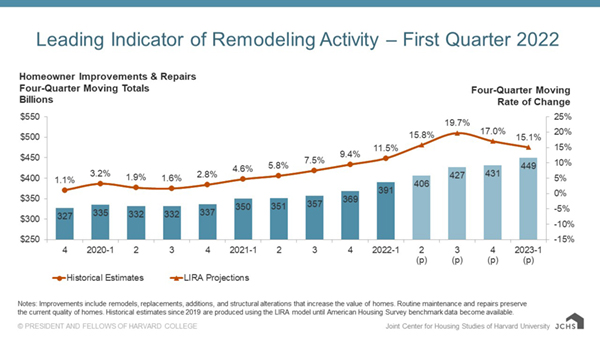Red Hot Remodeling Growth Expected to Ease into 2023

CAMBRIDGE, MA – Expenditures for improvements and repairs to the owner-occupied housing stock are expected to grow throughout 2022 and into early next year, but at a decelerating pace, according to the Leading Indicator of Remodeling Activity (LIRA) released today by the Remodeling Futures Program at the Joint Center for Housing Studies of Harvard University. The LIRA projects year-over-year increases in residential renovation and maintenance spending will peak at 19.7 percent in the third quarter of this year before sliding downward to 15.1 percent in the first quarter of 2023.
“Massive increases in house price appreciation and the resulting levels of tappable home equity will continue to support remodeling activity this year and into next,” says Carlos Martín, Project Director of the Remodeling Futures Program at the Center. “Many other market indicators including existing home sales, renovation permitting, and retail sales of building materials also continue to grow at high, albeit slowing, rates.”
“The level of annual expenditures for home improvements and repairs is set to expand to nearly $450 billion by the first quarter of 2023,” says Abbe Will, Associate Project Director of the Remodeling Futures Program. “Yet, the rising costs of project financing, construction materials, and labor, as well as growing concerns about a broader economic slowdown or recession may further slow remodeling growth.”
Click image for full-size chart.
The Leading Indicator of Remodeling Activity (LIRA) provides a short-term outlook of national home improvement and repair spending to owner-occupied homes. The indicator, measured as an annual rate-of-change of its components, is designed to project the annual rate of change in spending for the current quarter and subsequent four quarters, and is intended to help identify future turning points in the business cycle of the home improvement and repair industry. Originally developed in 2007, the LIRA was re-benchmarked in April 2016 to a broader market measure based on the biennial American Housing Survey.
The LIRA is released by the Remodeling Futures Program at the Joint Center for Housing Studies of Harvard University in the third week after each quarter’s closing. The next LIRA release date is July 19, 2022 (NOTE DATE CHANGE).
The Remodeling Futures Program, initiated by the Joint Center for Housing Studies in 1995, is a comprehensive study of the factors influencing the growth and changing characteristics of housing renovation and repair activity in the United States. The Program seeks to produce a better understanding of the home improvement industry and its relationship to the broader residential construction industry.
The Harvard Joint Center for Housing Studies advances understanding of housing issues and informs policy. Through its research, education, and public outreach programs, the Center helps leaders in government, business, and the civic sectors make decisions that effectively address the needs of cities and communities. Through graduate and executive courses, as well as fellowships and internship opportunities, the Center also trains and inspires the next generation of housing leaders.
Contact: Kerry Donahue, 617-495-7640, [email protected]

